Just as coins and cards each have a grading system, stamps have a grading system as well. Although grading stamps is a complex and subjective process, I’d like to explain how it’s done in a way that’s easy to follow and understand. When I first took an interest in the grading process, it took me months to learn. It shouldn’t take that long, and my goal with this article is to make the process easy for anyone to learn in a couple hours or so. Technically, you could finish reading this article and “know how” to grade stamps in less than ten minutes, but as they say, “practice makes perfect” and to perfect this skill will definitely take a lot longer than ten minutes. 😉
A stamp grade tells you several things about a stamp, such as its centering and condition, its rough value, and its desirability. However, one very important thing to keep in mind is that there are thousands, perhaps millions of different types of stamps, and that one stamp’s “grade” can only be compared to another stamp of the exact same issue. For instance, if two stamps of the same issue, such as the Classics Forever issue, each had a different grade, the one with the higher grade would be worth more. But if they both had the same grade, neither would be worth more than the other. On the contrary, if two stamps carried the same grade but were from separate issues, it’s unlikely that they’d also carry the same value. One could be worth $1 million, and the other just a dollar.
Stamp grades are based on three factors: centering, condition, and eye appeal. Centering and condition play major roles in determining a stamp’s grade, while eye appeal simply adds a slight “bonus” or “discount” to the grade depending on whether a stamp has “excellent” or “poor” eye appeal. I’ll explain each determining factor in much more detail in a moment. For now I just wanted to get you familiar with each factor since you’ll be using them every single time you grade a stamp.
Learning to grade stamps yourself is handy for several reasons. Obviously it’s free; you won’t have to pay professional graders. But more importantly, knowing how to grade stamps will empower you with priceless knowledge when purchasing an ungraded stamp. You’ll be able to determine a stamp’s approximate grade, value, and scarcity.
Of course, there are some downsides and flaws with grading stamps yourself…. First off, no one has to agree with the grade you assigned a stamp. In fact, it’s very likely that your grade is different (probably higher) than what a professional grader would assign it. If you plan to sell self-graded stamps, they won’t sell for any more than what the buyer thinks their grade is. And, they’d sell for far less than they would if they were certified with a real grade.
So although grading stamps yourself isn’t the most dependable approach, at least it’s free, and most of all, it’s powerful knowledge to have as a collector.
How to Grade Stamps Yourself
I recently wrote an article which introduced the concept of stamp grading. If you’re unfamiliar with stamp grading, that article is definitely a must-read.
Determine the Centering
The first step in grading a stamp is determining its centering. This step takes lots of practice to master. Centering refers to how well centered the stamp’s design is within the margins. The highest grade a stamp can receive is “gem”. Each grade below gem means slightly worse centering. The infographic below shows how each grade corresponds with a stamp’s centering:
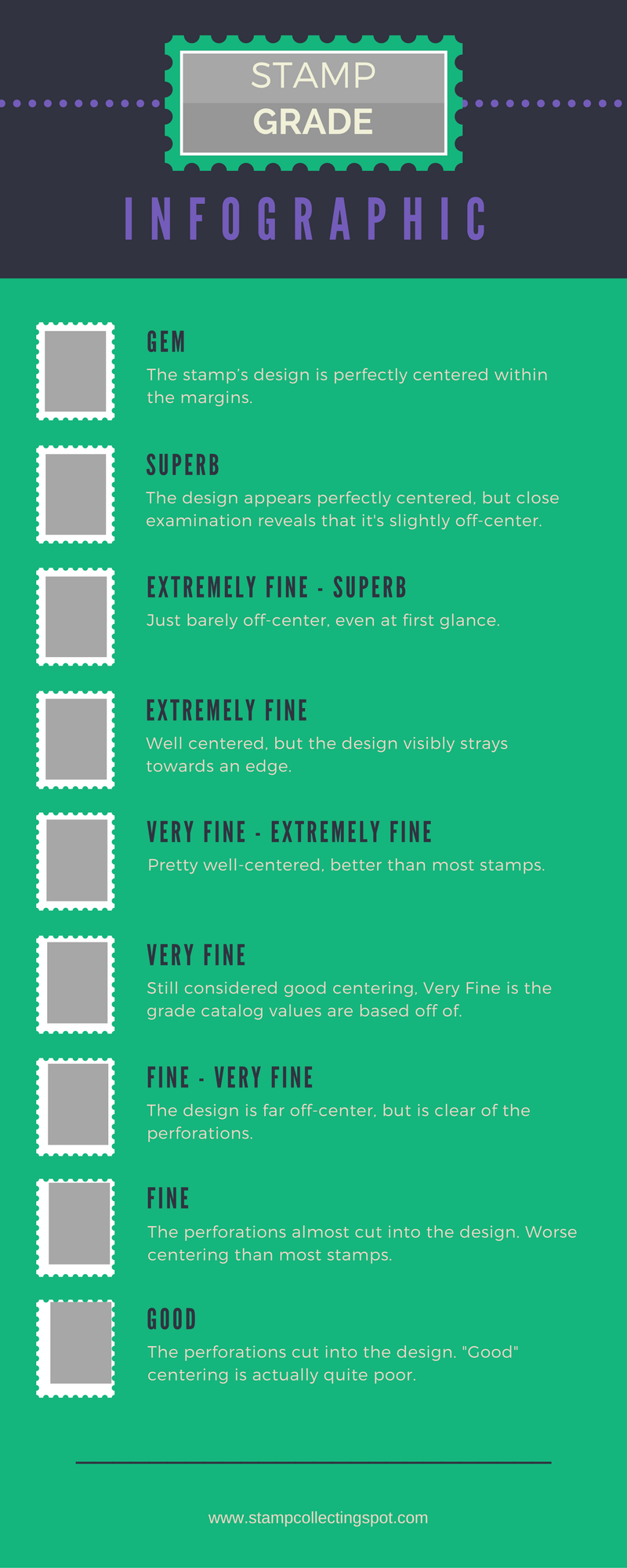
Once a stamp’s centering grade is determined, it’s time to factor in its condition and eye appeal.
Determine the Condition
The second step in grading a stamp is determining its condition. If a stamp has any faults, especially major faults such as pinholes or tears, grading is pretty much pointless. Faulty stamps don’t sell well, are in low demand, and in general should be avoided when forming a collection. However, stamps with minor faults such as an inclusion or a fingerprint on the gum, can be worth grading if they carry any value. Listed below are the various faults and their affect on a grade:
Stamp Faults
There are a number of faults a stamp can have. Old stamps in particular are more prone to faults, by virtue of their age.
Faults almost always bring down the overall grade, some more than others. For example, a very minor fault may only bring the grade down from Very Fine to Fine, while a major fault would bring it from Very Fine to Good, or even render the stamp ungradable.
Notice how at the beginning of the last paragraph I said faults “almost always” bring the grade down? Well, there are actually some faults that are so minor that they have no affect on the grade at all. Following is a list of these faults:
Gum Skips
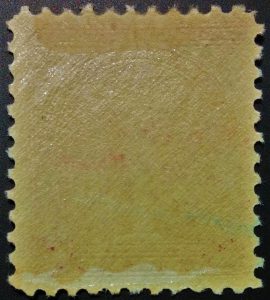
During the stamp production process, the gum was not always applied evenly over every stamp. Gum skips are areas on the back of a stamp that received no gum in the manufacturing process. Gum skips will not reduce the grade, although they are considered a trivial fault.
Fingerprints on the Gum
Since fingers are moist with skin oil, touching the gum on the back of a stamp can leave a fingerprint. Fingerprints are considered a fault, but don’t lower the overall grade of a stamp.
Regum
Sometimes collectors will regum a no-gum stamp, with the intention of increasing the stamp’s value. Regummed stamps are considered as no-gum and are far less desirable than original gum stamps, but their grade is not reduced.
*****
The following faults don’t quite fit into the above category, because depending on their severity may not lower the grade, or they could lower the grade by several steps.
Disturbed gum/gum bends/gum wrinkles/gum creases
These trivial gum faults don’t lower the overall grade, unless they affect the stamp’s frontal appearance. Depending on the severity of the fault, the grade could be reduced by just one step, or by several steps.
Inclusion
An inclusion is a foreign piece of material that was pressed into the stamp paper during the production process. Inclusions appear as a fleck of color on a stamp, usually brown or black. Inclusions generally don’t bring the grade down unless they are on the face of the stamp. And if that’s the case, the amount by which the grade is reduced depends on the size of the inclusion.
Foxing/stains/toning

Brown spots on a stamp, primarily caused by exposure to acidic paper, moisture, or sunlight. Depending on the severity of the spots, the grade may not even be reduced or it could be reduced by several steps.
*****
The following faults bring the grade down by at least one step:
Short Perfs (Perforations)
Short perfs are simply shorter-than-normal perforations. Short perfs usually reduce the grade by just one step.
Clipped Perfs
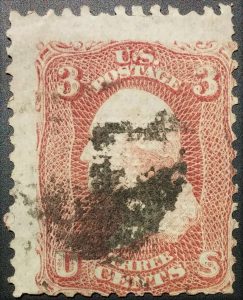
Clipped perfs are perforations that were cut short by scissors. Depending on the number of clipped perfs a stamp has, the grade could be reduced by one step or by multiple steps.
Surface Scrapes
A surface scrape is where a portion of the stamp’s face is scraped off, leaving a blank area. Depending on the size, a surface scrape can reduce the grade by just one step, or by many steps.
*****
The next set of faults all bring the grade down by several steps. If they’re severe enough, the stamp would be considered ungradable.
Thin
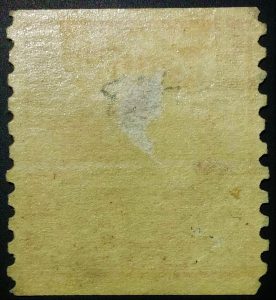
A thin means that a portion of a stamp is thinner than the remainder of the stamp. Tiny thins bring the grade down by just one step, but average or large-sized thins can bring the grade down considerably, and even render a stamp ungradable.
Tears
Tears are considered major faults, and depending on the size will reduce the grade by just a little, or even cause a stamp to be ungradable.
Creases
Also considered major faults, depending on their severity, creases can reduce the grade considerably or cause a stamp to be ungradeable.
Heavy Cancels
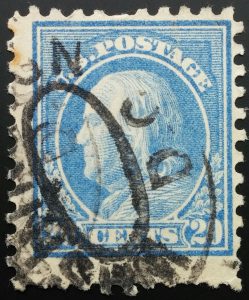
Heavy cancels are considered a fault, drastically reducing the stamp’s eye appeal. Heavy cancels can lower the grade by one or two steps.
*****
And finally, the following faults make a stamp ungradable. Stamps with these faults are considered “spacefillers”.
Straight Edges
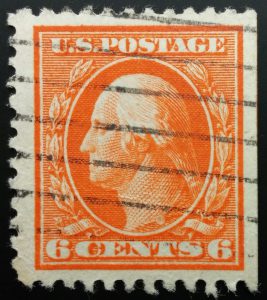
One or more edges of a stamp are straight, without perforations. Straight edges are the result of a stamp having been from the edge or corner of a sheet. Straight edges are considered major faults, and a stamp with a straight edge or two is ungradable.
Re-perforation
An alteration made to a stamp by adding fake perforations with the intention of improving the stamp’s eye appeal and value. A re-perforated stamp cannot be graded.
Pinholes
Considered as major faults, stamps with pinholes are ungradable.
Pieces Missing
Of course, if a stamp has missing pieces it is considered ungradable. Many also consider these stamps “trash”.
After both a stamp’s centering and condition have been taken into account, the final step is to determine the stamp’s eye appeal.
Determine the Eye Appeal
Eye appeal rarely affects a grade. And when it does, the affect is almost always minimal.
All stamps have some sort of eye appeal, whether it be excellent, average or poor. Most stamps have average eye appeal, which doesn’t affect their grade.
Stamps with excellent eye appeal enjoy an increased grade, and those with poor eye appeal suffer a discount to their grade.
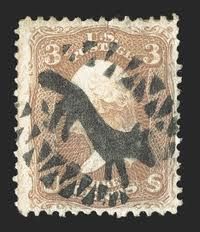
Fancy cancels, very light cancels, uncommonly vivid color, and a crisp, “Post Office fresh” feel are among the qualities that increase a stamp’s eye appeal, and therefore grade. In general, these qualities increase the grade by one step.

Limpness, heavy cancels, and pen cancels all decrease the eye appeal and grade. Poor “qualities” like these usually decrease the grade by one step, but if they’re severe enough, can decrease the grade by several steps.
Once every factor – centering, condition, and eye appeal – have been determined, a final grade can be established.
Review
Now I know that this was probably very confusing if you’re completely new to the concept of grading stamps, so I want to walk you through the exact process again by grading this stamp:
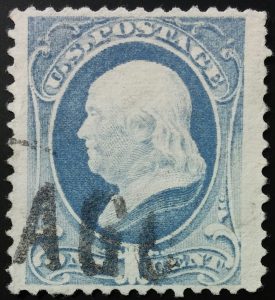
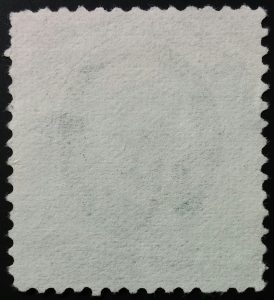
The first step is to determine the centering. The design strays towards the left side, and slightly to the bottom. I’d say this stamp has Very Fine – Extremely Fine centering.
Now that I’ve established the centering grade, it’s time to factor in the condition. This stamp’s only fault is three short perfs in the upper-right corner. These short perfs aren’t severe faults, but still bring the grade down by a couple of steps to Fine – Very Fine.
The final step is determining the eye appeal. This stamp has average eye appeal, meaning the grade is unaffected.
This brings us to the final grade: Fine – Very Fine.
Further Reading
When learning a new skill, such as grading stamps, it’s always a good idea to learn from several different sources, not just one. Below are some of the articles that helped me when I was learning to grade stamps:
2-Clicks-Stamps Grading and Condition
MCPhilatelics Stamp Terminology
eBay Guide – How to Grade Stamps
Conclusion
Grading stamps definitely takes some practice to get the hang of it, but in reality, it’s not that difficult. And the end result is that you’ll have gained some extremely valuable knowledge, become a well-rounded and smarter collector, and be a better informed and more savvy stamp buyer.
Hope you learned something new today. 🙂 If you’ve got any questions or comments in regards to grading stamps, please leave a comment below. I’d love to hear from you, and help out in any way I can.

A must-read, indeed! It’s a very useful and complete article, thanks for share with us! Regards, Catalin
Hi Catalin,
Thanks for the comment! It took me a while to put together this post, so I’m excited to hear your positive feedback. 🙂
Ian
Ian, doesn’t age and scarcity affect the value of a stamp? Even if they are ungradeable.
Hi Helen,
Correct, age and scarcity will always affect a stamp’s value even if it’s ungradeable.
Ian